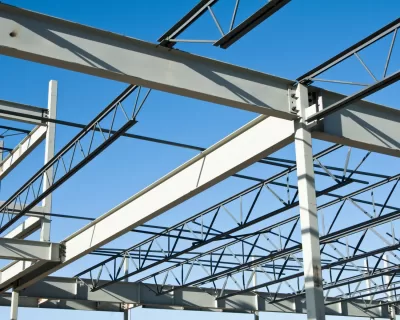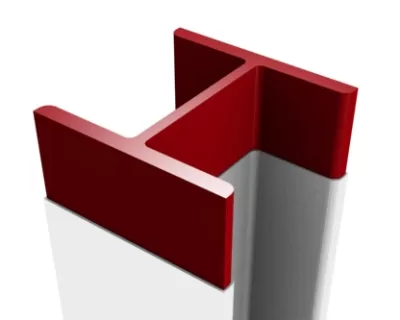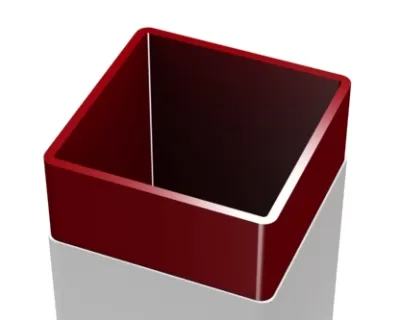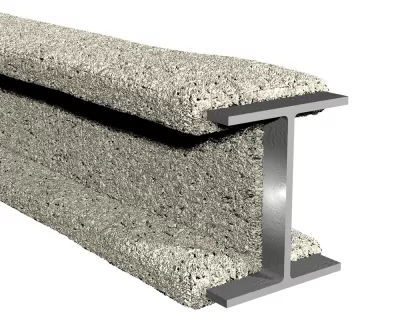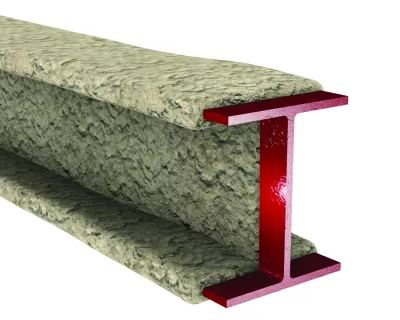Key Insights
Intumescent paint, also known as an intumescent coating, is used in construction to protect the structural adequacy of the building and prevent the collapse of the structure in case of a fire.
Many architects specify fireproof paints for structural steel fire protection, as it allows the incorporation of steel structures as an architectural design feature
How does intumescent paint work?
Steel beams, steel plates, and steel columns are used extensively in the construction as it is designed to have a good strength/weight ratio, however, load bearing steel elements are subject to structural failure when temperatures start to rise above 500°C. Most building fires exceed that temperature at some point and protective coatings are used to insulate these structural elements and prevent the collapse of the building.
When exposed to high temperature, the fire resistant paint expands in a controlled manner to many times its original thickness, producing a carbonaceous char formed by a large number of small bubbles. The material forms an insulating layer which slows the temperature of the steel rising to a critical level.
Where is fireproofing paint required?
Intumescent coating is commonly used on the steel elements of a building such as steel beams and columns to preserve the stability of its structure in the event of a fire.
It is a good solution to achieve attractive surface finishes and is typically used to easily cover complex shapes.
The thin film intumescent paint is applied directly to the contour of primed I and H section columns, angles, channels, beams and hollow sections to provide fire protection for up to 120 minutes depending on the product and environment.
Intumescent coatings can also be used on structural members made of wood, in this case, the protection is not as much about the heat, but more about stopping the spread of flame and smoke.
The fire resistant paint aims to provide enough time for the safe evacuation of the occupants of the building and provide a level of safety for the fire fighting teams looking to save the building.
How is it applied?
Intumescent coatings are preferably spray applied with airless paint equipment, however, brush and roller application are also an option. Depending on whether the protected steel surface is going to be seen, it is going to be covered up upon project completion, a spray application will provide a better quality of finish.
For any intumescent coating to work correctly a charring distance must be left around all coated surfaces (minimum of 50mm clearance).
Coatings can be applied either on or off-site, however, if off-site, the connection plates and bolts are still required to be protected once the steel is erected on site.
How to specify intumescent paint?
Knowing how to specify intumescent paint is important to reduce any delays at construction time. The use of intumescent paint in modern commercial construction has been developing over many years. The research and development of new technologies such as thin-film water-based intumescents have ensured the increased use of these types of products in today’s built environment.
In respect to passive fire protection, there are three ways of protecting a buildings structural steel frame. These are:
Board based systems – PROMATECT 250
Intumescent paint – Cafco Sprayfilm WB3
Vermiculite spray fire protection and Cementitious sprays – Cafco 300 and Cafco Fendolite MII
When specifying intumescent paint there are numerous factors that must be considered. These include:
- Fire Resistance Level (FRL) required
- Environment: Internal or External
- Areas of Application
- Steel Members and Section Factors
We have put together a white paper to assist architects, engineers, specifiers and building certifiers with correctly specifying intumescent paint so that it meets the current building codes and regulations.
To download your free copy enter your details in the form at the bottom of the page and we will send it to you.
What are the benefits of using Promat fire rated paint for fireproofing steel beams and columns?
Cafco® SPRAYFILM WB3 is a water-based intumescent coating made of polyvinyl acetate resins and fillers for the fire protection of structural elements in a building:
- Compatible with commonly used primers
- Compatible with many topcoats to provide durability for various usage categories, from internal to external application
- Thin and seamless finish
- Quick application and easy cleanup
- Suitable for both open and hollow sections
- Suitable for application onto galvanised steel
- Fast drying time
FAQ
Does it need a primer?
A: Yes- for steelwork intumescent paints must be applied on a primed element. Before being coated with a compatible primer, steelwork must be prepared according to SA 2.5. If that is already the case, it must be cleaned and free from grease, oil, rust, dirt or any other contaminant that may inhibit the bonding.
Compatible primers, tested with Promat products are:
- Acrylic
- Alkyd Zinc Phosphate
- Two component epoxy
- Zinc rich epoxy
- Zinc silicate
Although a tie coat will be required for Zinc Rich and Zinc Silicate
How much does it cost?
A: Depending on the project requirements the price may vary and fire resistant paint for steel or vermiculite spray fire protection might not be the best option. Please contact our team of experts for advice on what system is recommended for your project and get a custom quote tailored to your specific requirements.
Who makes intumescent paint?
Progressive Materials is the official supplier of Promat products in Western Australia. Promat is the leading brand of fire protection steel products in Australia and has been used worldwide for over 40 years.
Promat is a worldwide producer of fire protective boards made from calcium silicate, intumescent paints, mortars, fire glazing, fire stopping and a wide variety of steel fireproofing products for high performance insulation in industry, transport and energetics.
Does it need a top coat?
Yes intumescent paint systems require top coats for the following reasons
- Aesthetics
- Protection of the underlying intumescent coating
- Warranty purposes .
External use of top coats is required due to high ambient humidity application. Applying a top coat on intumescent paint provides protection to the structural steel element against environmental degradation. Top coats should be inspected and maintained regularly in line with the manufacturer’s requirements.
The main chemical families of topcoat used for environmental protection are:
- two component polyurethane top coat
- two component acrylic polyurethane
- copolymer acrylic
- polyurethane
- acrylic PU
- epoxy
How long does it take to dry?
Depending on the product, brand used and environment conditions, the drying time may vary. The Cafco® SPRAYFILM WB3 water-based intumescent coating has a drying time of 6 hours if applied within a temperature of 5 °C and a curing time of 7 days.




